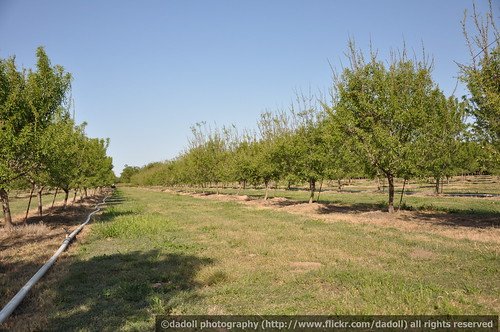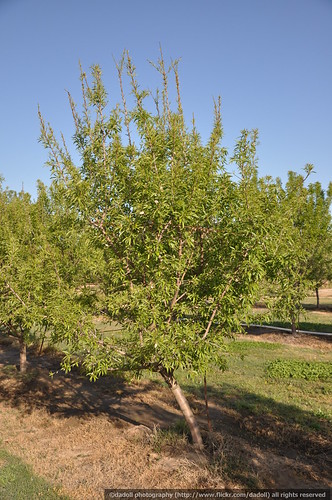A farm call in early April yielded a problem that proved to be difficult to diagnose due to complicating factors.
The orchard was three years old with three varieties planted on nemaguard rootstock: 50% Nonpareil, and two pollinators Monterrey (25%) and Avalon (25%). The soil was loamy sand to sand, very coarse, and a hardpan was present. Tree sites were backhoed before planting to remove the hardpan within the tree site. The previous cropping cycle was almond, but methyl bromide was used to fumigate the soil to kill nematodes, soil pathogens, and weeds. Irrigation is by moveable sprinklers.
Initial Observations:
Overall the orchard has variable growth overall. Some trees are large, some trees are smaller. Branches in the top of the tree have sparse growth. This growth, however, seems to be limited to one variety – the nonpareil. The symptoms are therefore found in every other row. Photo 1 shows the symptoms of sparse growth in the upper trees of one row.

Photo 1: Overview of the orchard showing symptoms. Note that the symptoms are more severe on one row of trees.
Up-Close Observations:
Sparse tree growth has tufts f leaves that are “bootstrapped.” Leaves are deformed are have not completely formed physiologically. Photos 2 shows a symptomatic tree and photo 3 shows a close up of effected leaves.

Photo 2: An individual tree showing symptoms of poor leaf growth and development.

Photo 3: An isolated branch showing “bootstrapped” leaves.
Possible causes:
Glyphosate (Herbicide) damage (Round-up)
Dormant applications of chloropyrifos (insecticide) (Lorsban)
Zinc Deficiency
Diagnosing:
The applications of chloropyrifos, a broad spectrum insecticide, can sometimes lead to similar growth responses in almond when applied in the delayed dormant stage. Questioning of the grower yielded that no chloropyrifos was used within the orchard – in fact, he doesn’t use chloropyrifos in any of his orchards. Good – one down, two to go.
Questions about the use of glyphosate were also asked to the grower. He stated that no glyphosate was used within the orchard. The pest control advisor (PCA) also seconded the fact by saying that no glyphosate was ordered by the grower. This eliminates direct application by the grower, but not by issues of herbicide drift or accidental exposure by having remnants of the herbicide left in a spray tank.
Drift concerns were brought up. The grower agreed that drift was possible, but said that no glyphosate was used in the orchard to the south (an organic block), and very little was used in the orchard to the north. Prevailing winds are from North to South, but storms will have winds blow from South to North.
The question for me was why one variety is only showing the symptoms. Calling upon other experienced colleagues, they indicated that different varieties have different timing of “pushing” the buds in the spring. During this period, a variety may have tissues that are softer or harder than another variety. If glyphosate was drifted into the orchard, the nonpareil could have been more sensitive to the chemical, showing more severe symptoms.
Zinc deficiency causes a similar growth response. In fact, when showing pictures to my colleagues, the diagnoses was either zinc deficiency or glyphosate injury. Zinc deficiency often causes tufting and/or rosetting of the leaves in NEW growth. Since most metal cations are not moveable within the plant, old growth usually appears healthy when new growth appears deficient. This is why iron chlorosis always shows up on the new growth first. The grower mentioned that zinc foliar sprays were applied during the postharvest period. Being zinc deficient was a concern since they are on sandy soils. He mentioned that a spring zinc foliar spray was being scheduled and should remedy the situation if that was the problem.
So..down to two possibilities: Glyphosate and zinc deficiency. Only time will differentiate which is the correct problem/diagnosis. A check back in two weeks would reveal the condition of new growth. If it was glyphosate damage, the new growth will still show signs of glyphosate injury (bootstrapping of leaves, compacted growth, etc.). If it was zinc deficiency, and the grower does apply a zinc foliar spray, the new growth should appear closer to normal.
Three weeks later I went back to check the site. New growth was still rossetted/tufted, but the symptoms were not as severe as before and the leaves were fully developed. I was informed that a zinc foliar spray was made about two weeks prior to the visit. This strongly suggests that zinc deficiency was responsible for the symptoms. If it was glyphosate, the new growth would still have been showing severe symptoms of “bootstrapped” leaves.
Solution/Prevention of zinc deficiency:
Correction for zinc deficiency is as follows: 10 pounds of basic zinc sulfate applied in at least 100 gallons of water per acre. Two applications should be made, two weeks apart. If rain occurs proximal to the application, shot holing of the leaves may occur from the reactivation of the zinc remaing on the surface whose chelated “safening” molecule has degraded.


MAT kinase
June 8, 2009I hope that come November you recommend spraying for leaf curl “after turkey, before pie.”